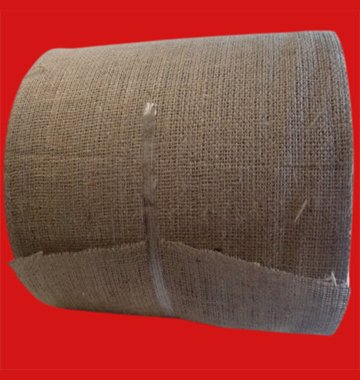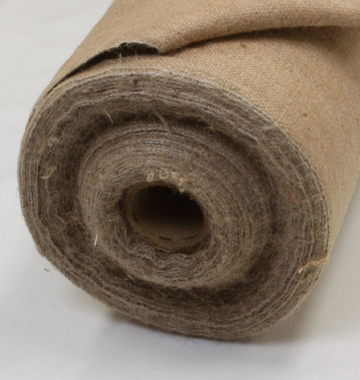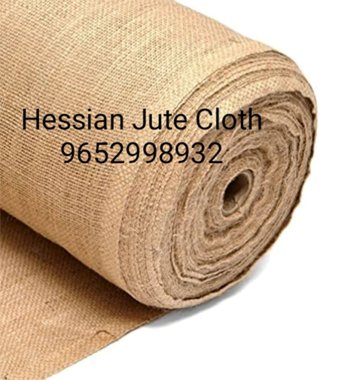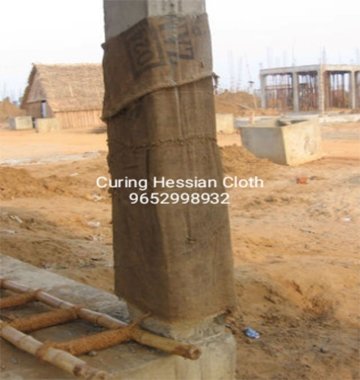Hessian Cloth
Hessian Cloth : – Hessian cloth, also known as burlap in some regions, is a versatile and coarse-woven fabric made from the fibers of the jute plant (Corchorus olitorius and Corchorus capsularis). It has a long history and is used for a wide range of practical and decorative purposes. Here are some key characteristics and common uses of hessian cloth:
- **Material:** Hessian cloth is primarily made from natural jute fibers. Jute is a sustainable and eco-friendly plant fiber, making hessian an environmentally friendly material.
- **Coarse Texture::** Hessian is known for its rough and coarse texture. It has an open weave, which allows air and moisture to pass through. This texture makes it suitable for various practical applications.
- **Color:** Hessian cloth typically comes in a natural tan or brown color due to the natural color of jute fibers. However, it can be dyed or bleached for decorative or specific purposes.
- **Strength and Durability:** Hessian is a relatively strong and durable fabric, making it suitable for heavy-duty tasks and applications.
- **Biodegradability:** Hessian is biodegradable and compostable, which makes it an eco-friendly choice for various uses.
- **Packaging:** Hessian cloth is often used for packaging goods, especially agricultural products like grains, fruits, and vegetables. Its breathable and moisture-absorbing properties help protect perishable items during transportation.
- **Erosion Control:** Hessian is used in landscaping and construction for erosion control. It is laid over soil to prevent erosion by wind and water while allowing plants to grow through it.
- **Gardening:** Gardeners use hessian for various purposes, including wrapping tree roots during transplantation, creating frost protection barriers for plants, and making plant covers or bags.
- **Crafts and Decor:** Hessian is popular in arts and crafts for making rustic and natural-looking decorations, such as table runners, banners, and wreaths. It can also be used for upholstery and as a decorative fabric in home dcor.
- **Agricultural and Farming Uses:** In agriculture, hessian cloth is used for making sacks for storing and transporting crops like potatoes, coffee, and cocoa beans.
- **Textiles and Apparel:** While hessian is not typically used for clothing due to its coarse texture, it can be used for making accessories like bags and aprons. It’s also used in the fashion industry for rustic-themed items.
- **Construction and Building:** Hessian cloth can be used in construction as a temporary weather barrier or to protect fresh concrete from drying too quickly, which can cause cracks.
- **Art and Theater:** In art and theater, hessian is used for creating textured backgrounds, props, and set designs.
Hessian cloth’s versatility and natural properties make it a valuable material in various industries and creative endeavors. Its ability to provide protection, strength, and a rustic aesthetic has contributed to its enduring popularity.
The weight of hessian cloth can vary depending on several factors, including its dimensions (length and width) and thickness. Hessian cloth is typically sold by weight per unit area, such as grams per square meter (g/m) or ounces per square yard (oz/yd). The weight per unit area is a measure of the fabric’s density, and it can vary based on the specific requirements of the application.
- **Lightweight Hessian:** This type of hessian cloth is often used for decorative and craft purposes. It typically ranges from about 100 g/m (3 oz/yd) to 200 g/m (6 oz/yd). Lightweight hessian is suitable for projects where a finer texture and flexibility are desired.
- **Mediumweight Hessian:** Mediumweight hessian is commonly used for packaging, gardening, and erosion control. It typically ranges from about 200 g/m (6 oz/yd) to 300 g/m (9 oz/yd). This range offers a good balance between strength and flexibility.
- **Heavyweight Hessian:** Heavyweight hessian cloth is used for more rugged applications, such as heavy-duty packaging, construction, and erosion control in areas with significant water flow. It can weigh over 300 g/m (9 oz/yd) and provide robust protection and durability.
The specific weight of a hessian cloth product should be specified by the manufacturer or supplier on the product label or in product specifications. When selecting hessian cloth for a particular application, consider the weight per unit area, as well as the fabric’s weave and texture, to ensure it meets the requirements of your project.
Keep in mind that hessian cloth may also be available in various widths and lengths, so the total weight of a piece or roll of hessian cloth can be calculated by multiplying the weight per unit area by the surface area (length x width) of the fabric.
Hessian cloth, also known as burlap in some regions, is primarily made from natural jute fibers. Jute is a vegetable fiber derived from the stem of the jute plant (Corchorus olitorius and Corchorus capsularis). These plants are primarily grown in regions with tropical climates, including parts of India, Bangladesh, China, and other countries.
- **Natural Fiber:** Jute is a natural, biodegradable fiber, making it an eco-friendly choice for various applications.
- **Coarse Texture:** Jute fibers are coarse and have a rough texture, which contributes to the distinctive appearance and texture of hessian cloth.
- **Strength:** Jute fibers are relatively strong, and hessian cloth made from jute is durable and able to withstand heavy use.
- **Breathable:** Hessian cloth has an open weave that allows air and moisture to pass through, which is beneficial for applications like packaging and gardening.
- **Biodegradable:** Jute fibers are biodegradable, meaning they can naturally decompose over time, reducing environmental impact.
- **Renewable Resource:** Jute is a renewable resource because it is derived from plants that can be replanted and grown relatively quickly.
Hessian cloth is prized for its versatility and use in a wide range of applications, including packaging, gardening, erosion control, crafts, textiles, and more. It is particularly popular in applications where its natural and coarse texture, breathability, and strength are advantageous.
Curing hessian cloth, also known as wet curing hessian or wet burlap, is used in construction for the wet curing of freshly poured concrete. Its length can vary based on the manufacturer and the specific requirements of the project. However, it is commonly available in standard lengths suitable for various construction applications.
– **10 meters (approximately 33 feet)**: This is a common length for smaller construction projects or DIY applications.
– **20 meters (approximately 66 feet)**: Longer rolls are often used for medium-sized construction jobs.
– **50 meters (approximately 164 feet) or more**: Longer rolls are suitable for larger-scale construction projects or when more material is needed.
The choice of curing hessian cloth length depends on the size and scope of the concrete curing task. Contractors and construction professionals typically purchase curing hessian cloth in rolls of the desired length to ensure they have enough material to cover and protect the freshly poured concrete effectively.
When procuring curing hessian cloth, it’s important to consider the dimensions and coverage required for the concrete curing process. The hessian cloth should be adequately wetted and placed over the concrete surface to maintain moisture and promote proper curing, which is essential for the concrete’s strength and durability.
Hessian cloth, also known as burlap, is a woven fabric made from natural jute fibers. The finishing of hessian cloth can vary depending on its intended use and the manufacturer’s specifications. Here are some common finishing options and treatments that may be applied to hessian cloth:
- **Plain/Unfinished:** In its natural state, hessian cloth has a coarse and rough texture. It may be left plain or unfinished for applications where its natural appearance and texture are desirable, such as in rustic and decorative projects.
- **Dyeing:** Hessian cloth can be dyed to change its color. Common colors include various shades of brown, but dyeing allows for a wide range of color options. Dyed hessian is often used in crafts, decor, and textiles.
- **Bleaching:** Bleaching is a process that lightens the natural color of hessian cloth. Bleached hessian is often used when a lighter or more neutral color is desired for crafting or decorative purposes.
- **Printing:** Hessian cloth can be printed with patterns, designs, or logos for branding or decorative purposes. Printing can be done with various inks or paints.
- **Laminating:** In some applications, hessian cloth may be laminated with other materials, such as plastic or rubber, to add water resistance or durability. This is common in agricultural and industrial uses.
- **Flame Retardant Treatment:** Flame retardant treatments can be applied to hessian cloth to make it less flammable. This is important in applications where fire safety is a concern.
- **Anti-Fungal Treatment:** Hessian cloth used in outdoor or humid environments may be treated to resist fungal growth and decay.
- **Coating:** Hessian cloth can be coated with various substances to enhance its properties. For example, it may be coated with wax for water resistance or with a stabilizing agent to reduce fraying.
- **Fringing or Hemming:** The edges of hessian cloth may be fringed or hemmed to prevent unraveling and improve the fabric’s appearance. This is often done for decorative or crafting purposes.
The finishing of hessian cloth is chosen based on the specific requirements of the application. For example, hessian used in agriculture or construction may have different finishing treatments compared to hessian used in crafts or home decor. When purchasing hessian cloth, you can inquire with the manufacturer or supplier about the available finishing options to ensure that you select the most suitable type for your project or application.
The quantity per pack of curing hessian cloth, used in construction for wet curing of freshly poured concrete, can vary based on the manufacturer, supplier, and the specific requirements of the project. These packs typically contain rolls or pieces of hessian cloth that are ready for use in concrete curing.
- **Single Rolls:** Some packs may contain a single roll of curing hessian cloth. This single roll can vary in length but is usually in the range of 10 meters (approximately 33 feet) to 50 meters (approximately 164 feet), depending on the manufacturer’s packaging.
- **Multiple Rolls:** Packs may include multiple rolls of curing hessian cloth. The number of rolls per pack can vary, and it is common to find packs with two or more rolls. The length of each roll may also vary.
- **Custom Quantities:** For larger construction projects or when specific lengths of curing hessian are required, custom quantities may be available. In such cases, you can work with the manufacturer or supplier to order the desired quantity and length of hessian cloth.
When purchasing curing hessian cloth for a construction project, it’s important to consider the surface area of the concrete that needs to be covered and protected during curing. The quantity per pack should align with the project’s requirements to ensure adequate coverage.
Always check the product label and inquire with the manufacturer or supplier to determine the specific quantity per pack and the length of each roll or piece of curing hessian cloth. This information will help you plan for the right amount of material needed for the concrete curing process.
Curing hessian cloth, also known as wet curing hessian or wet burlap, is primarily used in construction for the wet curing of freshly poured concrete. It is designed to retain moisture and promote proper curing conditions for concrete surfaces. There are generally two main types of curing hessian cloth based on their characteristics and applications:
- **Standard Curing Hessian:** Standard curing hessian cloth is the most common type used in construction for concrete curing. It typically consists of untreated or minimally treated hessian fabric. This type of hessian cloth is characterized by its coarse texture and natural color, often a tan or brown shade. Standard curing hessian allows for the controlled evaporation of water from the concrete while retaining enough moisture to ensure proper curing.
- **Treated Curing Hessian:** Treated curing hessian cloth undergoes additional treatments or coatings to enhance its performance during concrete curing. These treatments can include:
- – **Dyeing or Coloring:** Treated curing hessian may be dyed or colored to change its appearance. This can help with color-coding or identification on the construction site.
- – **Flame Retardant:** Some treated curing hessian cloth is treated with flame retardant chemicals to reduce its flammability. This is especially important when fire safety is a concern on construction sites.
- – **Anti-Fungal Treatment:** Treated curing hessian may be treated to resist fungal growth and decay, which can occur when the hessian is exposed to moisture over an extended period.
- – **Coating:** In some cases, hessian cloth may be coated with substances like wax or other water-resistant materials to improve its water-retaining properties.
The choice between standard and treated curing hessian cloth depends on the specific requirements of the construction project, local regulations, and any additional properties needed for the concrete curing process. Standard curing hessian is suitable for most concrete curing applications, while treated curing hessian may be used when specific properties or treatments are required to meet project specifications or safety standards.
The packing standard for curing hessian cloth, used in construction for the wet curing of freshly poured concrete, can vary depending on the manufacturer, supplier, and the specific requirements of the project. However, there are some common packaging standards and practices associated with curing hessian cloth:
- **Rolls:** Curing hessian cloth is typically packaged in rolls, making it easy to handle and dispense on construction sites. These rolls can vary in width, length, and weight per roll based on the manufacturer’s specifications.
- **Length per Roll:** The length of each roll of curing hessian cloth can vary widely. Common roll lengths for curing hessian cloth are in the range of 10 meters (approximately 33 feet) to 50 meters (approximately 164 feet) or more. The choice of roll length depends on the manufacturer’s packaging standards and the requirements of the construction project.
- **Width:** Curing hessian cloth rolls come in various widths to accommodate different applications and project needs. Common widths include 1 meter (approximately 3.3 feet) and 2 meters (approximately 6.6 feet), but other widths may also be available.
- **Packaging Material:** The rolls of curing hessian cloth are typically packaged in materials such as plastic, cardboard, or burlap bags. The packaging material provides protection during transportation and storage.
- **Labeling:** The packaging may include labels or markings that provide essential information about the product, such as the type of hessian cloth, roll length, width, and any treatment or specifications. Labels may also include safety instructions and usage guidelines.
- **Quantity per Pack:** The number of rolls or pieces of hessian cloth in each pack can vary. Some packs contain a single roll, while others may include multiple rolls. The quantity per pack is determined by the manufacturer and can depend on the project’s needs.
- **Custom Packaging:** In some cases, construction projects with specific requirements may request custom packaging for curing hessian cloth. This can include different roll lengths, widths, or quantities per pack.
When procuring curing hessian cloth for a construction project, it’s essential to consider the dimensions, quantity, and packaging specifications that meet the project’s needs. You can inquire with the manufacturer or supplier to ensure that the curing hessian cloth packaging aligns with your project’s requirements. Proper packaging helps protect the material during transit and makes it easier to handle and deploy on the construction site.
We can make high quality Hessian Cloth. We are exporters of hessian cloth in the market of Saudi Arabia, Oman, Dubai, Jordan, Kuwait and other middle east country , this cloth is used for curing purpose.
The construction of hessian cloth is 3 oz, 4 oz, 4.5 oz and 5 oz. porter and shot is 3×3, 4×4, 4×5 and 5×5
Bale :
- 25 yds x 5 cuts for 15 kg bale
- 70 yds x 10 cuts for 70 kgs bale
- 80 yds x 10 cuts for 70/80 kg bale
- 100 yds x 20 cuts for 205 kg bale
We also can make :
- 40 x 6oz,
- 40 x 6.5oz.
- 40 x 7oz
- 40 x 8.9oz
- 40 x 10 oz
- 45 x 7oz
- 45 x 8.9oz
- 45 x 10 oz
- 50 x 7oz.
- 50 x 10oz
- 44 x 8.9oz
- 51 – 13×14
- 51 14×15
These above quality is exported to Egypt, Iran etc.
We can make : 1000 yds bale and 2000 yds bale packing
Packaging of Hessian Cloth
as per ID: 4744:1991
And IS: 2873: 1991
Breaking Strength
Strip size (10x20cm)
1 Wrap way 112kgf min
2 Weft way 130 kgf min
3 Type of Cut
1 Full cut
2 Medium cut
3 Short cut
[09:40, 9/7/2023] Sandhya Enterprises: Hessian Cloth
Thickness
1 Light weight -5oz/yd2 (170 gsm)-2.0mm
2 Medium weight 7oz/Yd2 (238 gsm) -2.8mm
3 Medium weight 9oz/Yd2 (305gsm) -3.6mm
4 Heavy weight 10oz /Yd2 (340 gsm) -4.0mm
[10:00, 9/7/2023] Sandhya Enterprises: Hessian Cloth
Thickness
1 Light weight -5oz/yd2 (170 gsm)-2.0mm
2 Medium weight 7oz/Yd2 (238 gsm) -2.8mm
3 Medium weight 9oz/Yd2 (305gsm) -3.6mm
4 Heavy weight 10oz /Yd2 (340 gsm) -4.0mm
Hessian Cloth
Bale
1 25 Yds x5 Cut for 15kg Bale
2 70 Yds X10 cuts for 70 kgs bale
3 80 Ydsx10 cuts for 70/80 kg bale
4 100 Ydsx20 cuts for 205kg bale
Hessian Cloth
Features
1 High tearing strength
2 Long lasting nature
3 Resistance against shrinkage
4 100% Biodegradable
5 Durable
6 Long life
7 Light weight
8 Tesr Proof
9 Eco Friendly
10 Resistant to shrink
Hessian Cloth
Thickness
1 Light weight -5oz/yd2 (170 gsm)-2.0mm
2 Medium weight 7oz/Yd2 (238 gsm) -2.8mm
3 Medium weight 9oz/Yd2 (305gsm) -3.6mm
4 Heavy weight 10oz /Yd2 (340 gsm) -4.0mm
[09:20, 9/7/2023] Sandhya Enterprises: Hessian Cloth
1 Material
2 Texture
3 Colour
4 Strength
5 Breathability
[09:20, 9/7/2023] Sandhya Enterprises: Hessian Cloth
Bale
1 25 Yds x5 Cut for 15kg Bale
2 70 Yds X10 cuts for 70 kgs bale
3 80 Ydsx10 cuts for 70/80 kg bale
4 100 Ydsx20 cuts for 205kg bale
[09:20, 9/7/2023] Sandhya Enterprises: Hessian Cloth
Features
1 High tearing strength
2 Long lasting nature
3 Resistance against shrinkage
4 100% Biodegradable
5 Durable
6 Long life
7 Light weight
8 Tesr Proof
9 Eco Friendly
10 Resistant to shrink
[09:20, 9/7/2023] Sandhya Enterprises: Hessian Cloth
Specifications
S N Type.Details
1 Color. Brown
2 Packaging Type -Bale
3 Weight. – 330kg/Bale
4 Size/ Dimension -5oZ/6oZx39″x2000 Yard
5 GSM -150 -170
6 Length – 2000 Yard/ Bale
7 Usage Application -Packing Curing Puring
8 Width -20 inch (50cms) 46inch (115cms)
9 Style – Plain
10 Design – customer requirements
11 Material – Jute
12 Features – Eco Friendly
13 Pattern – Natural Burlap Bleached, Unbleached
14 Use -Bag Cover ,Garmet, Wrapping
15 Technics- Oven Knitted
16 Speciality – Optimum Strength
17 Application – Storage
18 Fabric – Can be bleached, Laminated Dyed
19 Durability – Long Life
20 Content – 100%Jute Fibers
21 Thickness -Medium Weight
22 Loading Ability – 24- 25 Tons
Sandhya Enterprises: Use and Application
Hessian Cloth
1 Agriculture and Gardening
2 Packaging and Shipping
3 Construction and Landscaping
4 Arts and Crafts
5 Upholstery and Home Decor
6 Agriculture and Horticulture
7 Industrial Application
Sandhya Enterprises: Hessian Cloth
Weight
1 Light weight -5oz/yd2 (170 gsm)
2 Medium weight 7oz/Yd2 (238 gsm)
3 Medium weight 9oz/Yd2 (305gsm)
4 Heavy weight 10oz /Yd2 (340 gsm)
Sandhya Enterprises: The main ways hessian fabric is used include:
Sandbags.
Foor storage.
Planter bags.
Nets.
Arts and crafts.
Interior design and upholstery.
Soundproofing.
Heat protection.
Sandhya Enterprises: Hessian Cloth
Thickness
1 Light weight -5oz/yd2 (170 gsm)-2.0mm
2 Medium weight 7oz/Yd2 (238 gsm) -2.8mm
3 Medium weight 9oz/Yd2 (305gsm) -3.6mm
4 Heavy weight 10oz /Yd2 (340 gsm) -4.0mm
[10:00, 9/7/2023] Sandhya Enterprises: Hessian Cloth
Thickness
1 Light weight -5oz/yd2 (170 gsm)-2.0mm
2 Medium weight 7oz/Yd2 (238 gsm) -2.8mm
3 Medium weight 9oz/Yd2 (305gsm) -3.6mm
4 Heavy weight 10oz /Yd2 (340 gsm) -4.0mm
Sandhya Enterprises: Packaging of Hessian Cloth
as per ID: 4744:1991
And IS: 2873: 1991
Breaking Strength
Strip size (10x20cm)
1 Wrap way 112kgf min
2 Weft way 130 kgf min
3 Type of Cut
1 Full cut
2 Medium cut
3 Short cut




